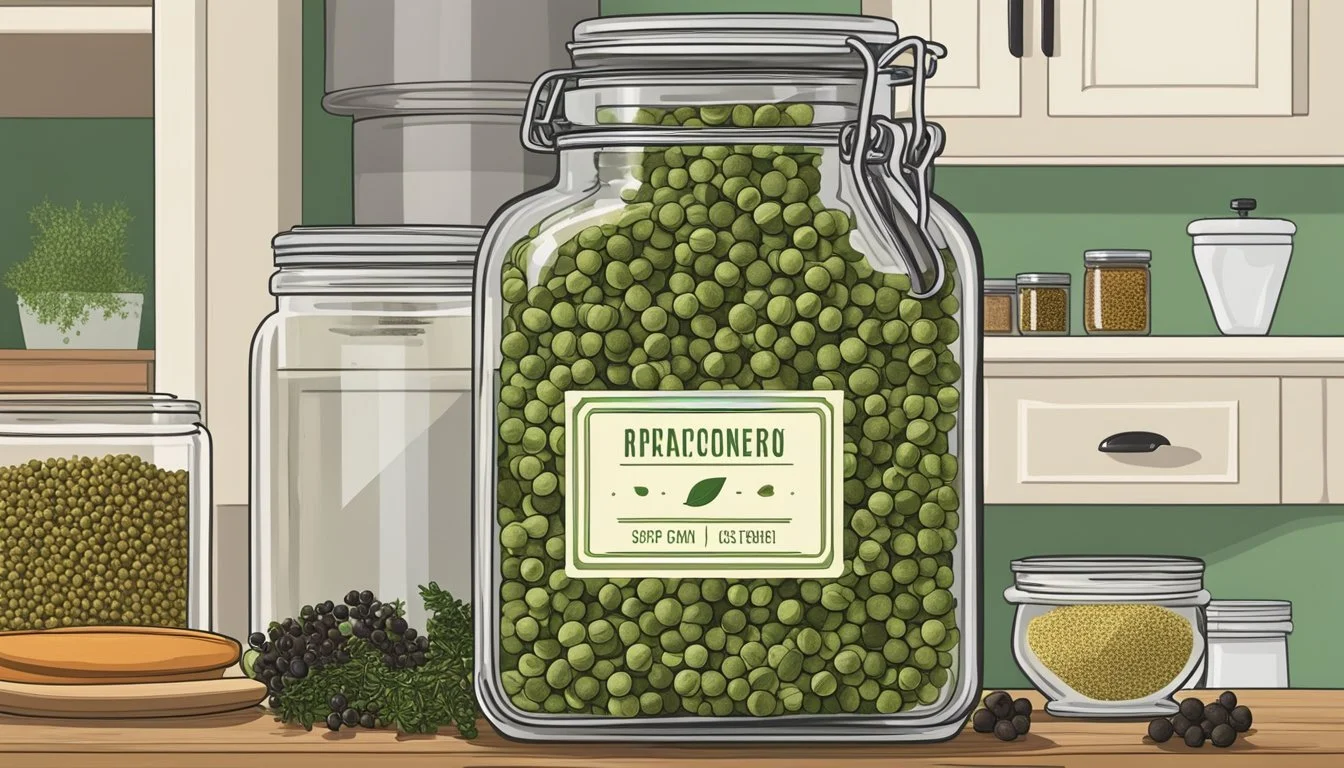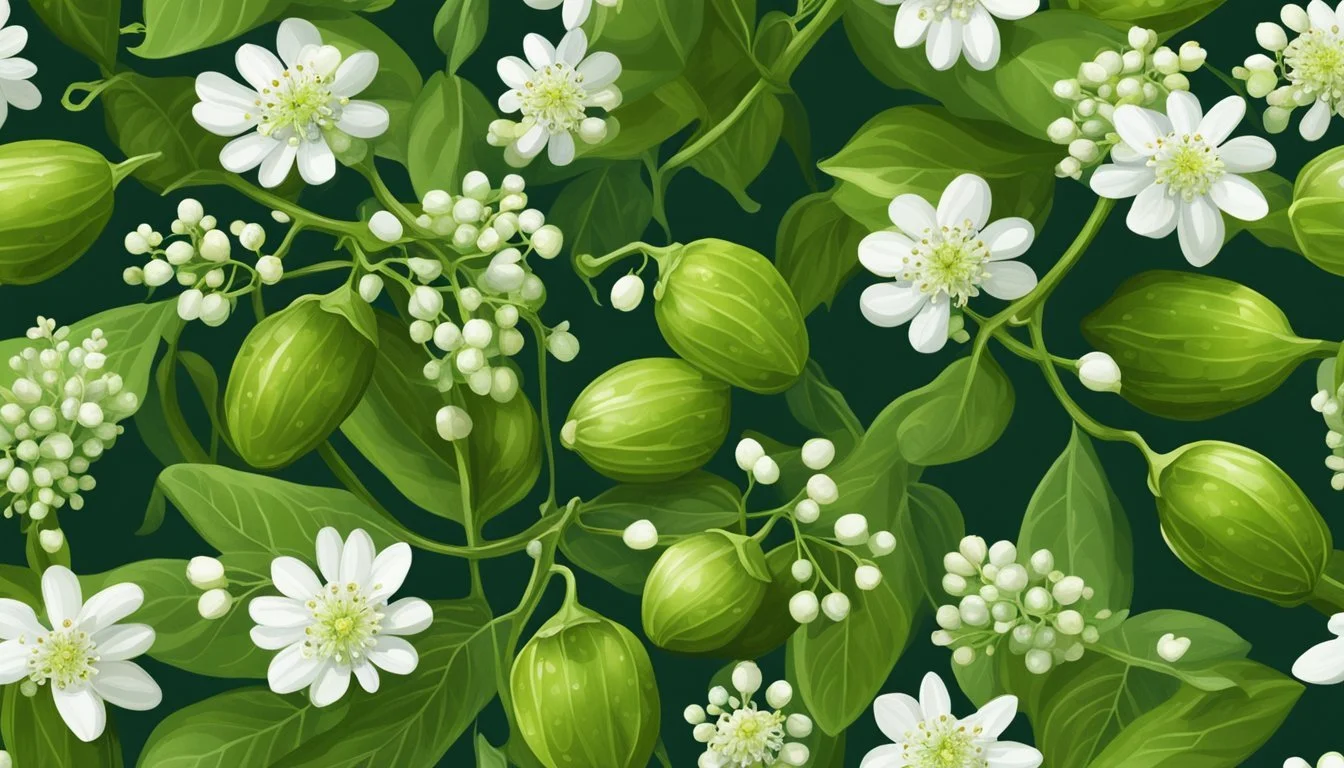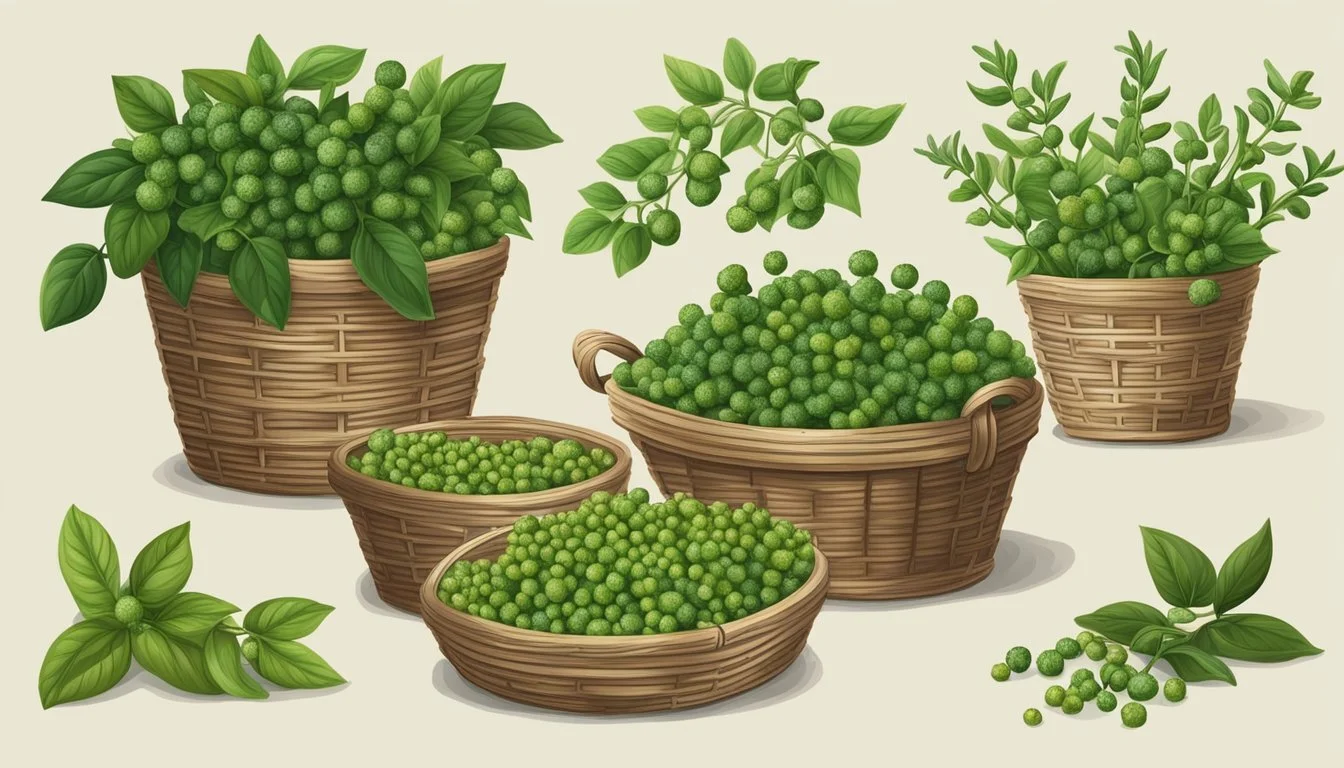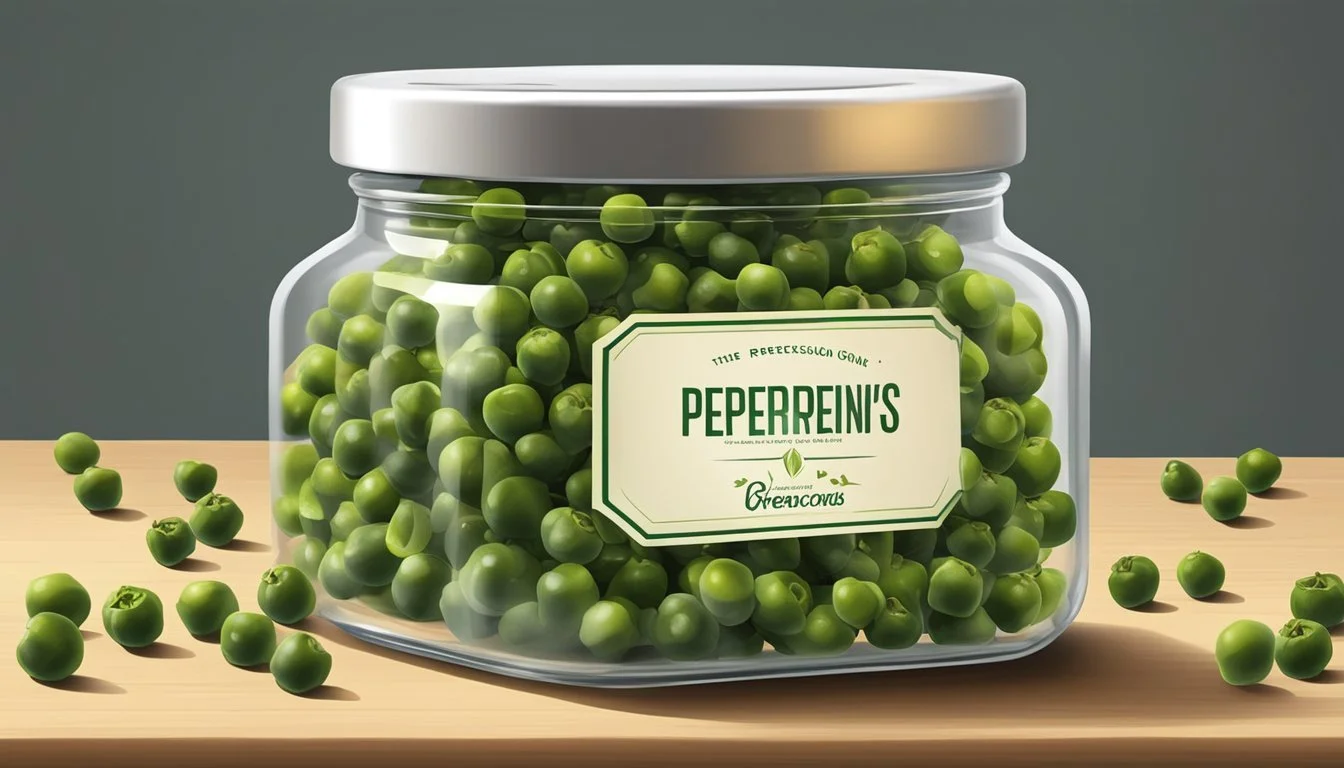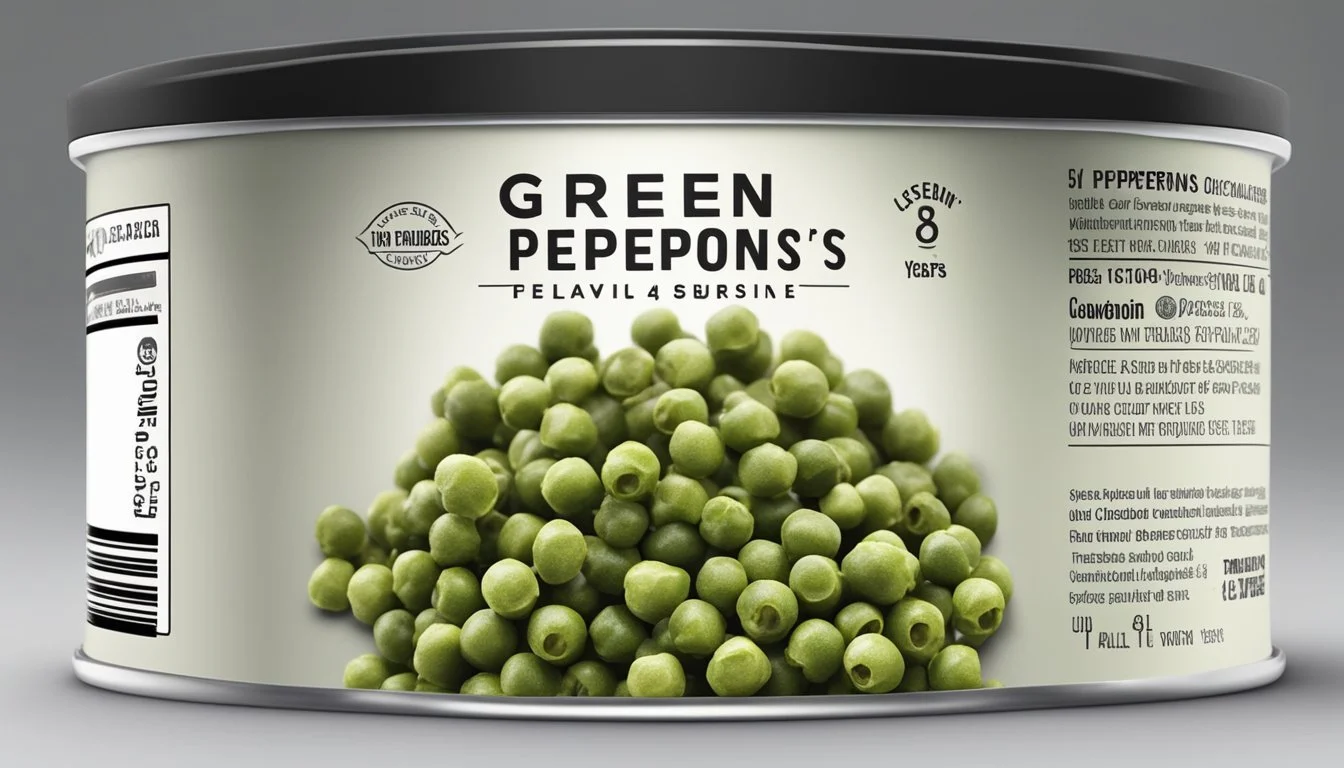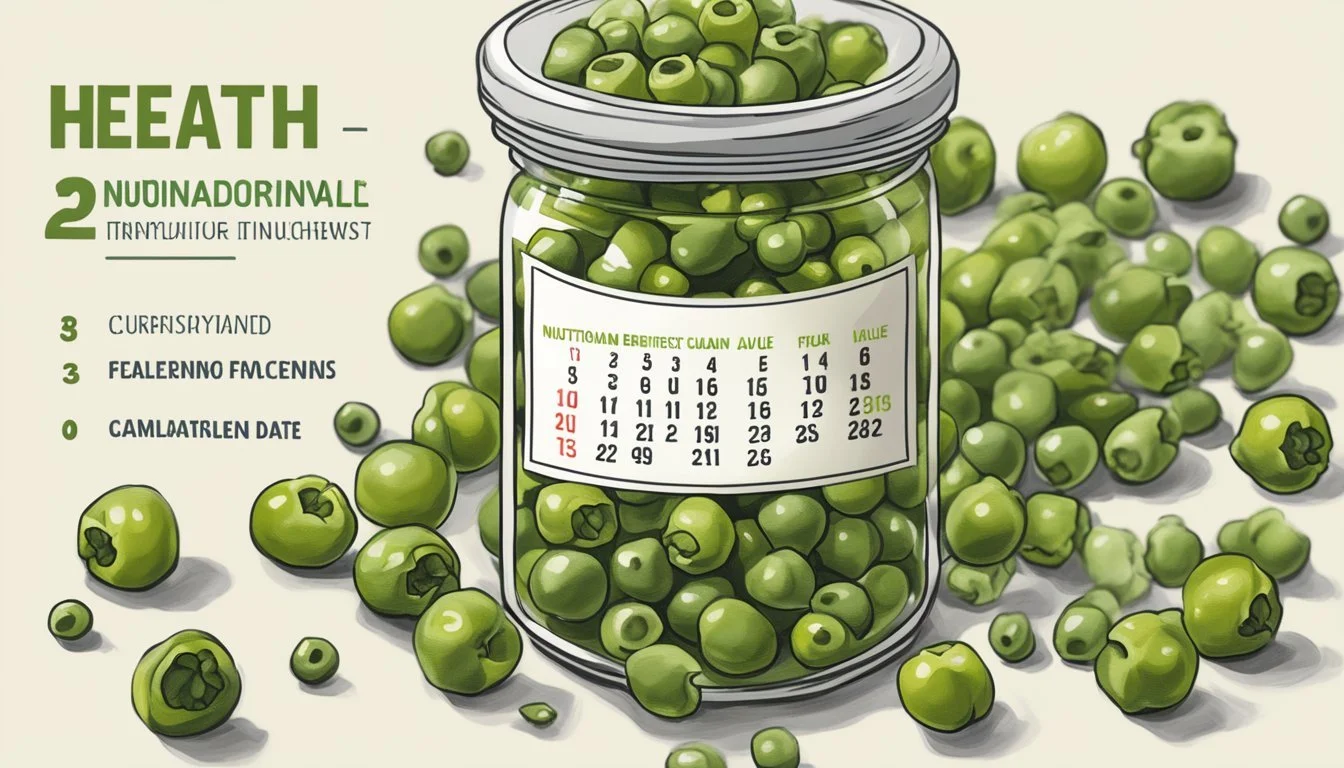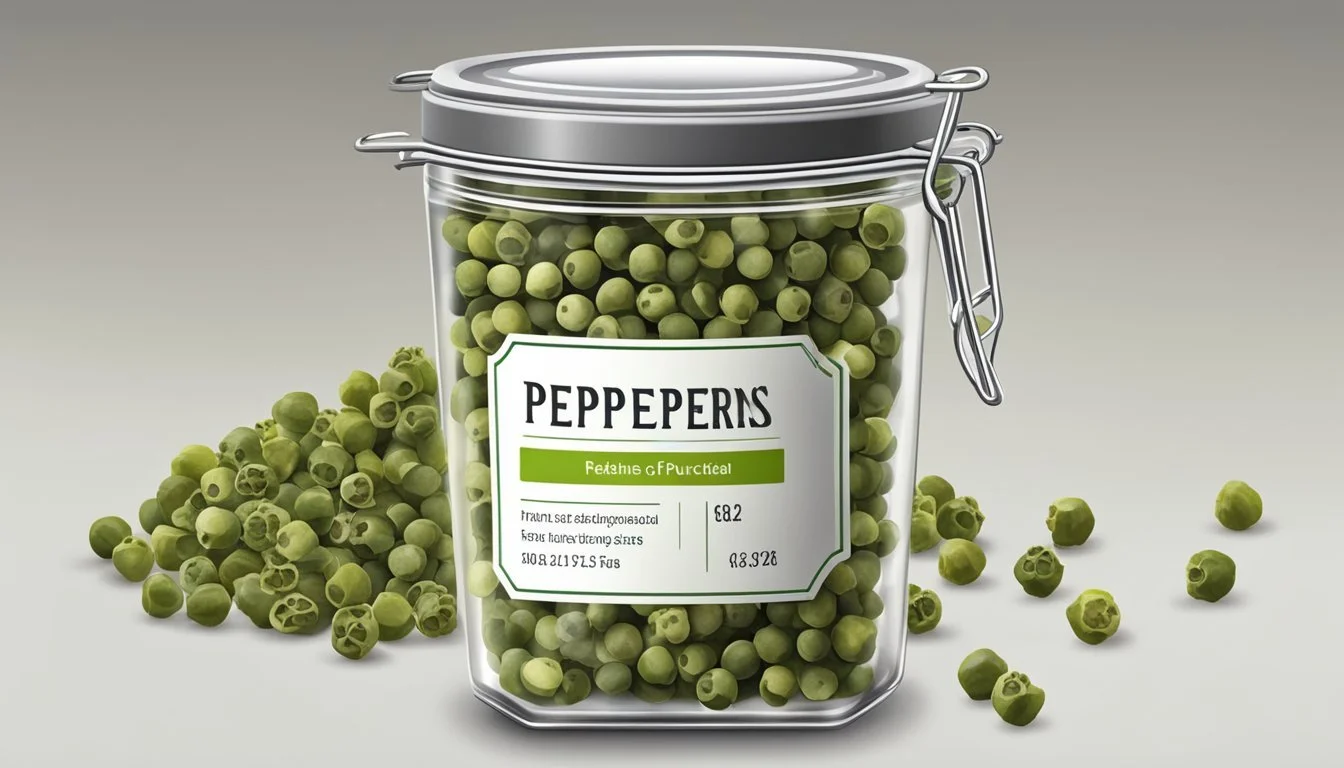How Long Do Green Peppercorns Last
Shelf Life and Storage Tips
Green peppercorns, the unripe berries of the Piper nigrum plant, present as a milder alternative to their black peppercorn counterparts. Prized for their fresh, aromatic flavor, green peppercorns are often used in a variety of cuisines to add a gentle heat to dishes. The shelf life of green peppercorns is an important consideration for keeping their distinctive flavor intact.
When stored properly, dried whole green peppercorns can maintain their potency for roughly a year. On the other hand, green peppercorns preserved in brine have a different shelf life, determined by the preserving process and the best before date stipulated by the manufacturer. A cool, dark place is the ideal storage environment to preserve the freshness and prevent the loss of the spicy essence that green peppercorns impart to culinary creations.
Factors influencing their shelf life include exposure to air, light, and moisture—common enemies of most spices, leading to loss of flavor and potential spoilage. The integrity of green peppercorns can be maximized by storing them in an airtight container to protect them from these elements. In doing so, chefs and culinary enthusiasts ensure that the green peppercorns' vitality is preserved for use in enhancing the taste profiles of various recipes.
The Basics of Green Peppercorns
Green peppercorns are integral to a variety of cuisines, offering a unique flavor profile that distinguishes them from their black, white, and red counterparts. They are not only vital for their taste, but they also contribute textural and visual nuances to dishes.
Definition and Characteristics
Green Peppercorns are the unripe berries of the Piper nigrum plant. Harvested before they mature, these peppercorns boast a vibrant green color and a tender, less brittle texture compared to fully ripened peppercorns. They have a fresh, slightly less pungent flavor, which can be described as zesty with a slight heat. Green peppercorns are commonly used in French, Thai, and other Southeast Asian cuisines, where they infuse dishes with a burst of flavor that is both sharp and nuanced.
Attribute Details Flavor Fresh, zesty, with a mild heat Color Vibrant green Texture Tender, less brittle than mature peppercorns Use in Cuisines French, Thai, Southeast Asian
Green peppercorns can be found in various forms including fresh, dried, or preserved in brine or vinegar. Their preservation method has a significant impact on their flavor and culinary uses.
Green Peppercorn Varieties and Origins
Green peppercorns are the unripe berries of the Piper nigrum plant, primarily cultivated in India and Indonesia. Their distinctive, less pungent flavor sets them apart from other peppercorn varieties.
Green Vs. Other Peppercorns
Green Peppercorns: Harvested before they mature, green peppercorns are milder in flavor and boast a fresh, bright quality. They are typically preserved in brine or vinegar or dried, retaining their green color.
Black Peppercorns: (how long do black peppercorns last?) These are the dried, fully mature fruits of the plant. After the outer layer is removed, the inner seed is dried, resulting in the wrinkled, black appearance. They have the strongest flavor of all peppercorn varieties.
White Peppercorns (how long do white peppercorns last?): White peppercorns are also mature berries but have undergone a process to remove the outer skin, revealing the inner white seed. They offer a more earthy, sometimes less spicy, flavor compared to their black counterparts.
Red Peppercorns: (how long does red peppercorns last?) Fully mature peppercorns that retain their outer shell are known as red peppercorns. They are often used in the same ways as black and white varieties but are less common commercially.
Variety: While these are all products of Piper nigrum and share a common origin predominantly from India and Indonesia, each peppercorn variety provides a unique flavor profile and culinary uses based on its state of ripeness and processing methods.
Freshness and Quality Indicators
When assessing the freshness and quality of green peppercorns, their aroma and taste, as well as texture and color, serve as crucial benchmarks.
Aroma and Taste
Green peppercorns should emit a bright, fresh fragrance indicative of their quality. Their taste is a reliable freshness indicator; fresh green peppercorns should have a mildly spicy and somewhat zesty flavor profile. If the peppercorns elicit a weakened aroma or a bland taste, this suggests they've lost their potency and should be replaced.
Texture and Color
The texture of green peppercorns should be moderately firm and moist, especially when preserved in brine. Dryness or shriveling can indicate age or improper storage. The color of fresh green peppercorns is typically a vibrant green. Any signs of dulling or discoloration point toward the degradation of the spice's quality.
Optimal Storage Practices
Storing green peppercorns correctly is essential to maintain their flavor and extend shelf life. The following subsections detail storage techniques tailored for both immediate use and long-term preservation.
Short-Term Storage
For short-term storage, green peppercorns should be kept in a sealed container or an airtight container to protect them from moisture and humidity. They need to be placed in a cool, dry place away from direct sunlight and heat sources. Ensuring a stable environment prevents flavor loss and maintains quality.
Long-Term Preservation
When it comes to long-term preservation, green peppercorns can be stored in the refrigerator or freezer to greatly extend their shelf life. If refrigerated, they should be in a tightly sealed container, which helps to retain potency and prevent the absorption of other flavors. For freezing, green peppercorns should be placed in a freezer-safe airtight container. Even in cold storage, one should ensure that the environment remains dry to avert freezer burn.
Shelf Life and Expiration
Understanding the shelf life and expiration of green peppercorns is essential for maintaining their flavor and usability. The longevity of these spices can be affected by various storage conditions.
Factors Affecting Shelf Life
Green peppercorns typically retain their quality for up to 1 year when stored appropriately. They are more delicate compared to black peppercorns due their less mature state. To preserve their shelf life, green peppercorns should be kept:
In a cool, dry place away from direct sunlight.
At a consistent room temperature to prevent degradation of essential oils.
In an airtight container to reduce exposure to air and moisture.
Away from humidity which can lead to spoilage.
When storing green peppercorns, it's important to check for any signs of moisture inside the container, as this can accelerate the loss of flavor and potentially introduce mold. While whole peppercorns have a longer shelf life, ground green peppercorns should be used more quickly, as grinding increases the surface area exposed to environmental factors that can lead to faster degradation.
Usage in Cooking
Green peppercorns are cherished for their mild, fresh flavor which is well-suited to a range of dishes. These unripe berries from the Piper nigrum vine bring a less intense heat compared to other peppercorn varieties, making them a favorite for subtle seasoning.
Green Peppercorn Applications
Sauces: They are often used whole or ground in peppercorn sauces that accompany steak and chicken, imparting a vibrant, zesty tang.
Vegetable Dishes: Green peppercorns can add a nuanced heat to vegetables, lifting the flavor profile without overpowering it.
Seafood Preparations: The spice's light freshness complements seafood and fish, enhancing their natural flavors.
Soups and Salads: Whole green peppercorns provide bursts of flavor to soups and salads, contrasting with other ingredients for a complex taste experience.
Seasoning Meat: When meat is prepared, green peppercorns can be crushed and rubbed onto the surface, blending with herbs to create a delectable crust.
Ground Spice: Ground green peppercorns offer a more consistent spice level and can be easily integrated into recipes as a seasoning alternative to black pepper.
Food Pairings and Recipe Ideas
Green peppercorns offer a unique and less pungent taste compared to their fully ripened counterparts, blending well in a multitude of dishes to enhance their flavor profile without overwhelming the senses.
Enhancing Flavors and Textures
Green peppercorns can transform simple ingredients into complex, flavor-rich dishes (What wine goes well with rich dishes?). When incorporated into recipes, they create a subtle heat and a fresh, herbaceous quality that compliments the natural tastes of various foods.
Meats:
Chicken: A classic French sauce with green peppercorns, known as "Sauce au Poivre Vert," can elegantly dress a grilled chicken breast.
Steak: The spiciness of crushed green peppercorns enriches the robust flavors of red meat.
Vegetables:
Asparagus, Green Beans: Sauté with a small amount of butter and green peppercorns to elevate these green vegetables.
Sauces:
Add whole green peppercorns to creamy sauces to introduce bursts of flavor, ideal for dressing over pork chops or veal.
Salads:
Whisk crushed green peppercorns into vinaigrettes for a zesty twist on salads.
Use as a garnish on top of a fresh Caesar or garden salad for an added taste dimension.
Incorporating green peppercorns into dishes enhances both the flavors and textures, providing an aromatic and gourmet experience with each bite.
Health Benefits and Nutritional Value
Green peppercorns are not only a culinary staple but also a source of several health benefits due to their nutritional components.
Green Peppercorns' Health Contributions
Green peppercorns are the unripe version of the black peppercorns that are often used in various dishes for their flavor. They are known for containing piperine, a compound that enhances nutrient absorption and stimulates hydrochloric acid production in the stomach, aiding digestion. Green peppercorns are also a source of antioxidants, compounds that help protect the body from free radicals, which are unstable molecules that can damage cells.
The health benefits of green peppercorns include:
Digestive Aid: The presence of piperine helps to increase the secretion of hydrochloric acid in the stomach, facilitating better digestion of proteins and other foods.
Antioxidant Properties: They contain antioxidants that combat oxidative stress and may contribute to the prevention of various diseases.
Here's a nutritional overview of green peppercorns:
Nutrient Benefit Piperine Enhances nutrient absorption, boosts metabolism Antioxidants Protects against cellular damage, supports immune function Dietary Fiber Promotes digestive health, aids in regular bowel movements
Green peppercorns, when included as part of a balanced diet, provide a unique combination of flavor and benefits. They serve as a versatile spice that not only enhances the taste of food but also contributes to overall well-being.
Culinary and Cultural Significance
Green peppercorns, derived from the Piper nigrum plant, hold a prominent place in global cuisines and have played a pivotal role in shaping economic trade flows across cultures.
Global Influence on Cuisine
Green peppercorns are celebrated for their unique, fresh flavor that is less pungent than their black peppercorn counterparts. They enhance a wide variety of dishes across many cuisines, contributing a mild heat and a bright aroma. In particular, they are a staple in Indian cooking, often found in traditional recipes that highlight their zesty character. Chefs around the world utilize green peppercorns to inject a burst of flavor into sauces, meats, and vegetable dishes.
Trade and Economic Impact
Historically, pepper acted as a form of currency, with Arab traders controlling the spice trade routes. Later, European explorers sought to bypass these intermediaries, sparking sea voyages that led to the "Age of Discovery." The trade of peppercorns contributed to the establishment of trade networks, including the famed Silk Road. The economic impact of pepper trade is evident, as it was a driving force in connecting distant markets, often described as the "Amazon" of ancient times. Its cultural significance in trade is best encapsulated by the spice's moniker, "black gold," highlighting its value to early economies.
Creative Uses and Alternative Applications
Green peppercorns offer a range of applications beyond their common use as a spice in traditional recipes. Their tangy, fresh flavor can elevate many dishes and inspire culinary innovation.
Beyond Traditional Cookery
Green peppercorns bring a zest that can transform a simple garnish into a talking point. Chefs often use them to add a bright note to creamy sauces and pâtés, where their subtle heat cuts through richness. In alternative applications, green peppercorns serve as more than just a spice. They can be crushed and used to infuse oils, imparting their distinct flavor and making a simple olive oil dip a memorable start to a meal.
When considering a non-culinary angle, green peppercorns can be incorporated into handmade fragrances. They share a botanical kinship with juniper, which is prevalent in many perfumes, adding a peppery twist to the scents. Additionally, due to their fresh and slightly fruity undertones, green peppercorns can be an innovative botanical addition to craft cocktails, offering a unique counterpart to the piney notes of juniper-based gins.
While pink peppercorns are not true peppercorns, they are sometimes used in conjunction with green varieties to offer a complex flavor profile in both culinary and mixology contexts, adding visual appeal and nuanced taste. As an alternative, dried green peppercorns can also be rehydrated by soaking them in brine or vinegar, which can then serve as a flavor-packed addition to marinades or as a vibrant topping for dishes.
By stepping outside traditional uses, one can discover that the vine that bears the green peppercorn is not just a source of spice, but a versatile ingredient waiting to be explored in various realms of food and sensory experiences.
Preservation Techniques
In preserving green peppercorns, various methods can be employed to extend their longevity. These techniques ensure the dried fruit retains its flavor and usability for culinary purposes.
Peppercorn Processing Methods
Green peppercorns, when freshly harvested, are known for their milder flavor profile. To preserve this distinct taste, they can be processed and stored in several ways:
Freeze-Drying: This process removes moisture from the peppercorns, making them less prone to spoilage. Freeze-dried green peppercorns can last for years when stored in an airtight container, away from heat and light.
Brining: Green peppercorns can be brined in a solution of water, vinegar, and salt. Brined green peppercorns are often refrigerated and can last for several months to a year.
Pickling: Similar to brining, pickling involves immersing the peppercorns in a mixture that often includes vinegar, water, and other spices. Pickled green peppercorns should be kept refrigerated and typically have a similar shelf life to brined ones.
The chosen storage method directly influences the longevity of green peppercorns. It is critical to store them in a cool, dark place to maximize their shelf life.
How to Determine Spoilage
Green peppercorns, like all spices, can lose their quality over time. Recognizing the signs of spoilage ensures that one uses only the best flavoring agents in their cuisine.
Indicators of Compromised Quality
Taste and Flavor: The taste of green peppercorns should be pungent and slightly fruity. If they become bland or lose their distinctive peppery flavor, this is a strong indicator that they have past their prime.
Smell and Aroma: Fresh green peppercorns have a vibrant aroma. A loss of aroma or an off-smell can signal spoilage.
Texture and Color: Fruits should maintain a certain level of moisture and firmness. Shriveled peppercorns or those that have lost their bright green color may be a sign of age or improper storage.
Expiration Date: While not always a perfect indicator due to spices often remaining safe beyond this date, a significantly surpassed expiration date can suggest reduced quality.
Storage Conditions: Green peppercorns last longer when stored in a cool, dry place away from heat and light. Storage in damp or hot conditions can accelerate spoilage.
One should inspect green peppercorns regularly for these signs and use them promptly to ensure the best culinary results.
Buying Tips and Best Practices
When purchasing green peppercorns, one's focus should be on freshness, flavor, and quality to ensure the best culinary experience.
Selecting Top-Quality Green Peppercorns
Freshness: Green peppercorns should be bought as fresh as possible. They are known for their vibrant green color and moist texture, which indicate freshness. One can usually find them in brine or freeze-dried. Freshness affects not only flavor but also the overall aroma, an essential attribute of green peppercorns.
Flavor & Aroma: The best green peppercorns have a characteristic fresh, bright aroma with a flavor that is less spicy than black peppercorns but with a unique, slightly tangy heat profile. Their flavor should be potent, as it is a marker of quality and freshness.
Variety: Look for reputable brands or sources that offer the specific variety of green peppercorns, commonly the Piper nigrum species.
Color & Texture: Upon inspection, the peppercorns should have a consistent green hue with no signs of dullness or yellowing, which can be an indicator of age. The texture should be firm to the touch if fresh, or appropriately dried if in a dehydrated form.
Green Peppercorn: Ensure that what you are purchasing is indeed green peppercorn, not unripe black peppercorn or another variant, as this will affect the intended flavor profile in dishes.
Handling and Preparing Green Peppercorns
Green peppercorns require careful handling to preserve their unique taste and are a versatile ingredient for seasoning in various recipes. They are often used to add a fresh, mildly spicy flavor to dishes.
Preparation Techniques
One must first determine whether they will use green peppercorns in their brined, dried, or fresh form, as this impacts the preparation technique. When ready to incorporate green peppercorns in cooking, they should be treated as follows:
Rinsing (if brined): If the peppercorns are brined, one should rinse them gently under cold water to remove excess brine, which can be too salty for some recipes.
Drying (if fresh): Fresh green peppercorns should be patted dry to remove any moisture that might affect the cooking process.
Grinding or Crushing: To release the full flavor of green peppercorns, they can be ground or crushed just before they are added to a dish. Grinding can be done using a pepper mill, mortar, and pestle, or the flat side of a knife if a coarser texture is desired.
Freshly Ground Pepper: For the most robust flavor, use freshly ground green peppercorns close to the time of cooking to preserve their volatile aromatics and oils.
Whole Peppercorns in Cooking: Whole green peppercorns can also be used in certain recipes, such as making peppercorn sauces or marinades, where they impart a milder heat and full-bodied taste.
It is important to note that overcooking can cause green peppercorns to become bitter, so they are best added towards the end of the cooking process. Additionally, matching green peppercorn's distinctive flavor to appropriate recipes ensures that the seasoning complements the dish without overpowering it.
Substitutes and Alternatives
When green peppercorns are unavailable, one may consider a variety of spices as alternatives that deliver closely related flavors and heat profiles to dishes.
Exploring Similar Spices
Black Peppercorns: Often available and a staple in most kitchens, black peppercorns provide a slightly spicier taste. They can be used as a substitute in a 1:1 ratio for green peppercorns.
Flavor Profile: Black pepper is more pungent with a sharp heat.
Best Used In: Meats, soups, and stews.
White Peppercorns: These come from the same plant as green peppercorns but are fully matured. White peppercorns are less intense and more earthy, making them a suitable replacement.
Flavor Profile: Milder than black peppercorn with a subtle heat.
Best Used In: White sauces and light-colored dishes.
Pink Peppercorns: Although not true peppercorns, they have a similar size and a more fruity, slightly sweet flavor. Use pink peppercorns when a less pungent heat is desired.
Flavor Profile: Sweet, fruity with a mild peppery taste.
Best Used In: Seafood dishes (What wine goes well with seafood dishes?) and in creating aesthetically pleasing pepper mixes.
Red Peppercorns: These are essentially ripe pink peppercorns and offer a similar fruity, sweet taste. Their color can add visual appeal to dishes.
Flavor Profile: Similar to pink but with a more pronounced sweetness.
Best Used In: Decorative finishing to dishes, salad dressings, and sauces.
Each alternative brings its own unique qualities to a dish, be it in terms of intensity, flavor, or visual appeal, providing ample options when green peppercorns are not an option.
Packing and Transport Considerations
When transporting green peppercorns, the primary concern is preserving their freshness and shelf life by preventing any quality degradation. Proper packaging is crucial in this process.
Maintaining Quality During Movement
To mitigate the risk of spoilage and extend the shelf life of green peppercorns during transport, one should use airtight containers or sealed jars. These containers prevent exposure to moisture and other contaminants. For shorter transit times, a sturdy plastic bag can suffice, provided it seals well.
Airtight Containers: The use of containers with an airtight seal is essential in maintaining the quality of green peppercorns. They should be robust, preventing air entry that can lead to loss of flavor and potential spoilage.
Sealed Jar: A sealed jar, preferably glass, can also be effective for both storage and transport. Glass doesn't react with the peppercorns and ensures the flavor remains unaltered.
Plastic Bag: For economic transportation, a high-quality plastic bag can be used. However, it's essential that the bag is not prone to punctures or tears and can be sealed tightly.
The containers should be kept in a controlled environment, shielded from direct sunlight, heat, and moisture, which could otherwise compromise the integrity of the peppercorns. The goal during transport is to mimic ideal storage conditions—a cool, dry, and dark environment—to maintain the peppercorns' pungency and prevent mold growth.
Pairing with Various Ingredients
In culinary applications, green peppercorns bring a unique combination of mild heat and fresh flavor that elevates a variety of dishes. When integrating them into recipes, understanding their compatibility with different ingredients is essential for achieving harmony on the palate.
Complementing Flavors and Dishes
Green peppercorns possess a bright and slightly tangy taste that can complement a vast range of ingredients. They are often utilized in:
Vegetables:
Asparagus
Green beans
Peas
For vegetables, they add a mild peppery note that can be particularly appealing in light sautés or steamed dishes. (What wine goes well with steamed dishes?)
Meat:
Pork
Beef (notably in steak au poivre)
Chicken
When it comes to meats, green peppercorns can enhance the flavor without overpowering the natural taste. They work exceptionally well in sauces served with steak or pork, and can also add a fresh zing to chicken dishes.
Seafood:
Fish fillets
Scallops (What wine goes well with scallops?)
Shrimp
Seafood benefits from the less intense heat of green peppercorns, resulting in a complement that accentuates the delicate flavors of the ocean.
Salads:
Use whole or crushed in fresh green salads
Dressings
Green peppercorns can be sprinkled over fresh salads for an added kick, or crushed into dressings for a more robust integration of their flavor.
Sauces:
Cream sauces
Brandy or wine reductions
The mild spiciness of green peppercorns works wonders in creamy sauces and can balance sweet reductions, enhancing the overall taste of a dish.
Incorporating green peppercorns into a variety of recipes and cuisines can introduce a nuanced layer of flavor that is both confident and distinctly enjoyable. They should be used with consideration for their ability to complement without dominating the flavor profile of the dish.
Comparisons to Other Pepper Forms
The shelf life of green peppercorns varies depending on their form, with whole, ground, and brined peppercorns each having distinct preservation characteristics.
Ground Vs. Whole Vs. Brined Peppercorns
Ground Peppercorns:
Shelf life: Typically lasts up to four months.
Storage: Best kept in an airtight container, protected from light and heat.
Whole Peppercorns:
Shelf life: Can be stored for up to a year when dry.
Storage: Requires a cool, dark place for optimal longevity.
Brined Peppercorns:
Shelf life: Once opened, they should be used relatively quickly but can last for a significant period if unopened.
Storage: Must be refrigerated after opening and kept in their brine for maximum freshness.

